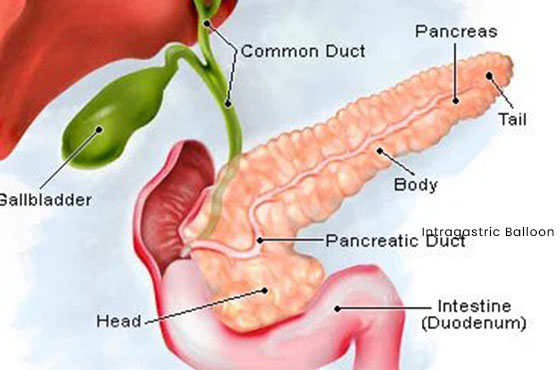
Pancreatic cysts are fluid filled cavities within the pancreas
Pancreatic cysts are fluid filled cavities within the pancreas. They may be as small as few millimeters but can be as large as several centimeters. Pancreatic cysts can occur at any age but are more common in middle to elderly age individuals. Cysts may form in the pancreas due to many reasons. Some cysts are present since birth. These are developmental anomalies, are usually small, do not cause any symptoms, are not of much consequence and do not need to be removed. More common are cysts that forms in the pancreas after a bout of severe pancreatic inflammation or acute pancreatitis. Such cysts are called pseudopancreatic cysts. Certain forms of pancreatic cancers can also appear as cysts and these are known as cystic pancreatic tumors. There are also some cysts in the pancreas which are pre-cancerous and can progress to cancer over time. Overall most pancreatic cysts are benign and non-cancerous. Only 1-2% are cancerous.
Pancreatic cysts, if small, may not cause any symptoms and are usually detected during ultrasound scans of the abdomen done for other reasons. An increasing number of patients are being diagnosed to have incidental pancreatic cysts since ultrasound and CT scans have become common imaging modalities. Large pancreatic cysts may cause abdominal pain or feeling of fullness in the upper abdomen. Large cysts may also compress surrounding organs such as stomach and lead to vomiting or compress the bile duct and cause jaundice. Large pancreatic cysts can rarely rupture and cause internal bleeding.
The most important thing is to distinguish whether a pancreatic cyst is related to inflammation of pancreas or not. Pseudopancreatic cysts are not pre-cancerous and can resolve once the pancreatic inflammation settles down. On the other hand, pancreatic cysts that are not related to pancreatic inflammation can be pre-cancerous or cancerous. It is important to identity such cysts because these may need to be surgically removed.
Investigations such as MRI scan of the pancreas, and endoscopic ultrasound are important to determine the type of cyst. Analysis of the fluid inside the cyst may also help in differentiating between different types of cysts. Small cysts less than 2 cm in size are generally observed and if there is no increase in size over 1 to 2 years, are assumed to be benign and do not usually need further investigations or treatment. Pseudocysts that form after acute pancreatitis need to be treated only if they are large (more than 5 cm) or are causing symptoms. In this case only the fluid and debris inside the cyst needs to be drained and this can be achieved endoscopically or laparoscopically. On the other hand, cysts that are proven to be cancer or suspected to be pre-cancerous need laparoscopic or open surgery for complete removal. On the other hand, a benign or non-cancerous cyst, even if large, may not need to be removed if it is not causing any symptoms.
